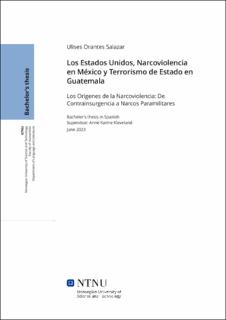| dc.description.abstract | This text provides a historical analysis of the origins of the narcoviolence currently experienced in Mexico, attributing it partially to U.S. interventions in the continent during the Cold War. It explains how the drug trafficking group known as Los Zetas, initially part of the Gulf Cartel, revolutionized the structure of drug organizations in the country. They introduced paramilitary structures and tactics of psychological terror using extreme violence, which their members were familiar with due to their military background, who also received training from Guatemalan Kaibiles. The Guatemalan Kaibiles were an elite group of the Guatemalan army that committed atrocities against the population during the Guatemalan Civil War (1960-1996). The text then explores how state terrorism was developed by the government during this civil war, supported by the United States, who trained, armed, and financed the Guatemalan security forces in the name of counterinsurgency and anti-communism. The purpose of this analysis is to highlight the consequences of U.S. interventions in Latin America and contribute to understanding of the origins of narcoviolence. | |
